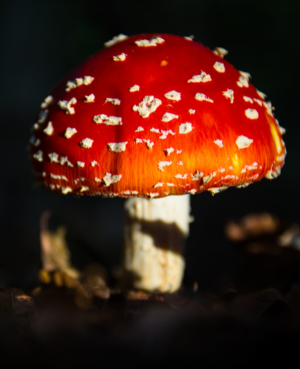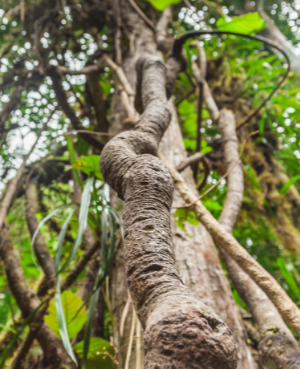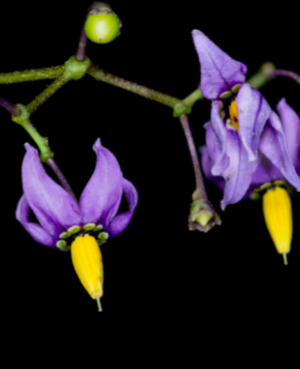"The shaman is not merely a sick man, or a madman...he is a sick man who has healed himself.” ~ Terrence McKenna
Amanita muscaria

Perhaps mans oldest hallucinogen. Used widely in Shamanic rituals and can be linked to the legendary Soma cults of the ancient Indo – Europeans (Aryans). Typically found growing under conifer and birch trees.
In Mayan & Aztec culture it is regarded as a door to the realm of the dead. Contains Ibotenic acid (a powerful neurotoxin) Muscarine (highly toxic) and Muscimol (a psychoactive alkaloid).
The majority of ibotenic acid is converted into muscimol when the mushroom is dried so it’s recommended not to consume raw. Siberian shamans would drink their urine or the urine of a reindeer that ate the sacred mushroom.
Despite being classified as poisonous, it can provide alleviation from many nervous disorders from anxiety and depression to epilepsy and dementia. Other positive effects include relief from muscle and joint pain and also potent anti-ageing effects when used topically. Known as the sleep mushroom, it can aid the user in journeying to other worlds or “astral travel” and can induce intense vivid dreams.
ayahuasca

A potent amazonian sacred brew made from leaves of the Psychotria viridis shrub combined with the stalks of the Banisteriopsis caapi vine and sometimes with other psychotropic plants native to the Amazon basin.
This psychedelic infusion has a long history of ceremonial consumption by various indigenous peoples throughout South America.
Psychotria Viridis contains DMT, a highly psychedelic substance that occurs naturally in the plant, however, it’s not accessible in the gut when consumed alone. It is broken down by an enzyme called monoamine oxidase which switches off the active effects of the DMT when ingested.
The Caapi vine contains a monoamine oxidase inhibitor which allows the DMT to be accessed orally – Amazonian Science.
Known for its healing properties, personal transformation purposes, and ability to communicate with the spirit realm.
An extraordinary visionary brew that allows the soul to be freed to wander, without corporeal confinement, otherwise known as an OBE (out-of-body experience).
datura

Belonging to the Nightshade family, datura is a powerful and dangerous deliriant, used for shamanic rituals and medicinal purposes.
Contains scopolamine hyoscyamine and atropine primarily in its seeds and flowers which are normally ingested or smoked.
Typical effects can last hours to days and even weeks after being consumed with extremely strong psychoactive effects which can induce a state of delirium to the unprepared user.
A shaman will use datura to intoxicate themselves to “open the crack between worlds” and induce intense altered states of consciousness for ceremonial purposes.
It is cultivated widely as a common garden plant for its beautiful large heavy scented flowers but with many unknown benefits. This powerful herb has been used holistically in Ayurvedic medicine for centuries for the treatment of various conditions including skin disorders, diabetes, heart problems and respiratory ailments when used in small doses.
To use your head, you have to go out of your mind.” ~Timothy Leary
Peyote

The name Peyote comes from the Aztec word peyōtl which means “Divine Messenger.” Native to Mexico & Texas, this hallucinogenic cactus has been used for millennia by shamans to induce states of deep insight along with intense psychedelic hallucinations and preventatively, to protect from illnesses.
Grows very slowly, taking up to thirteen years to fully mature. Peyote “buttons” are harvested and dried from the roots of the plant then eaten, brewed in a tea or powdered (known as mescaline sulphate).
Contains the psychoactive compound mescaline known to increase creative problem-solving and has anti-depression and anxiety-reducing properties, promoting a calmer state of mind. Other effects include closed and open-eyed visuals and time distortion and perception. Used culturally by Native Americans for ceremonial purposes. It has also been used to treat ailments such as joint pain, skin diseases, toothache and headaches.
liberty caps

Liberty Caps are famous for their hallucinogenic properties. Also known as witches’ hats or more commonly Magic Mushrooms.
They are the most widespread of the Psilocybe genus was used historically in European witchcraft and prefer to grow in grassy fields associated with cows or horses They are high to extremely potent and yellowish olive-brown when wet turning much paler creamy colour when dry.
Contains the compound psilocybin which produces euphoria, visual and mental hallucinations, changes in perception, a distorted sense of time and if taken in moderate to high dosage, a spiritual experience.
Once ingested, psilocybin is rapidly metabolized to psilocin, which then acts on serotonin receptors in the brain.
Used therapeutically to treat mental health and substance-use disorders such as depression, anxiety-related disorders, bipolar, autism, psychosis, and schizophrenia, and to treat various addictions.
san pedro

Known as the master teacher and spiritual healer, this South American Cactus is commonly used for its high mescaline content and wide range of medicinal purposes.
These include a range of emotional, mental, and physical disorders including addiction. Believed to aid one in being able to “let go of the illusions of the world” San Pedro is an extremely potent medicine.
It teaches us to live in balance and harmony, compassion and understanding and shows how to love, respect and honour all things.
Prepared by dicing the cactus and adding it to boiling water, the liquid is then concentrated through the process of evaporation and strained through a cloth then drank to produce the spiritual/psychedelic effects. Lasting 8-15 hours it is said to be more pleasant than Peyote, less overwhelming and generally a more tranquil experience.
Hallucingenic Hexing Herbs have been known since antiquity as potent medicines and fatal poisons with bizarre psychoactive effects.
Deadly nightshade

Belladonna has been used in herbal medicine for centuries despite its poisonous nature to relieve the symptoms of Parkinson’s disease.
Commonly used as a sedative, and in the past to dilate the pupils to make women look more beautiful hence the name.
Homoeopathic uses include treating fear-related mental disorders, vertigo, headaches, sore throat, tonsillitis, cough, earache, colic and fever.
mandrake

Infused with wine to create a psychoactive beverage called “cows eye” and for protection magic.
It was said that if the plant was collected improperly the human-like root would shriek, driving anyone who heard the noise mad.
Used to treat a huge range of ailments including cramps, eye disease, headaches, hysteria, infertility, inflammation, loss of speech, melancholy, menstrual problems, sleeplessness, stomach ailments, swollen glands and tumours. It is also used holistically as a treatment for anxiety and depression.
yellow henbane

Holistically used to treat various respiratory ailments, including asthma, bronchitis, and coughs.
black henbane

Known as the plant of the god Apollo. Used commonly in ancient Europe for shamanic rituals as it has similar effects to Datura.
Associated with witchcraft or magic, particularly love magic. Used to treat asthma, insomnia, toothache and a variety of nervous disorders.
Brugmanisa
Native to South America and closely related to Datura, this beautiful but deadly plant has powerful hallucinogenic properties. Containing tropane alkaloids and Scopolamine.
Commonly used by Andean priests in order to see the future and to diagnose diseases.
South American shamans strongly warn against untrained individuals working with angel’s trumpets, and they are used almost exclusively by only very experienced shamans. Brugmansia overdose may result in delirium that lasts for days.
WAVY CAPs
Better known as Wavy Caps or Brownies. Commonly found on rotting wood chip mulch in the autumn and winter.
The main compounds responsible for its psychedelic effects are psilocybin and psilocin.
Don’t Confuse With: The deadly poisonous Funeral Bell Galerina marginata this has a stem ring and doesn’t bruise blue.
5-meo-dmt

There’s something special about 5-MeO-DMT. It’s a psychoactive compound that is known to produce a powerful, 20-minute experience – a rocket-ship ride into hyperspace.
DISCLAIMER



